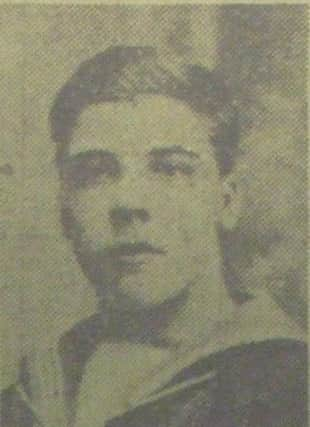Roamer: Artwork on wall commemorates Navy men killed in Jutland War


A poignant new artwork, launched today in Belfast’s Tennent Street, commemorates sailors from all over Ireland who died in the Battle of Jutland, almost 100 years ago on May 31, 1916.
The Jutland Square project, funded by the N.I.H.E Community Cohesion Unit, is a former graffiti black spot, re-imaged as a seven-panel art installation created by the Shared History Workshop.
Advertisement
Hide AdAdvertisement
Hide AdNorthern Ireland’s First Minister, D.U.P M.L.A Arlene Foster - who oversaw the restoration of H.M.S Caroline as D.E.T.I minister - will launch the Jutland Square project at Belfast’s Spectrum Centre, 331 Shankill Road, at 2pm this afternoon.
Chair of the Shared History Workshop, Karen O’Rawe, tells the tragic Jutland story for Roamer’s page today.
Before 1916 there hadn’t been a major sea battle between the world’s largest naval powers - Germany and Britain.
Just before 6pm on 31 May 1916 the Royal Navy intercepted the German fleet at Jutland, about 75 miles off the Danish coast.
Some 250 ships engaged in fierce fighting all evening.
Shells ripped into thick armour plating.
Advertisement
Hide AdAdvertisement
Hide AdShips exploded and sailors burned to death or were drowned in the ice-cold sea.
As darkness fell the German vessels headed back to port and the British fleet, concerned about enemy submarines and minefields, didn’t give chase.
Both sides claimed victory but despite the Royal Navy losing more ships and men, the battle left Britain in control of the North Sea as the German fleet made no further attempts to break the allied blockade or to engage the British fleet for the rest of the war.
The German naval effort after 1916 was left to U-boats.
The Battle of the Skagerrak or ‘Skagerrakschlacht’ as it was known in Germany, involved 100,000 men over the course of 72 hours.
Advertisement
Hide AdAdvertisement
Hide AdBritain lost 14 ships and 6,000 sailors. Germany lost 11 ships and 2,500 sailors.
Over 350 of the British sailors were from Ireland.
The Royal Navy lost two battle cruisers, Indefatigable and Queen Mary, in the first hour, along with 2,200 men.
H.M.S Indefatigable’s end came with a catastrophic explosion in her cordite stores.
Of over 1,000 crew members, all but two died.
At least 120 of her dead were from Ireland, including Belfast’s 21-year-old Able Seaman Douglas Sloane from Nile Street; 19-year-old Private William James McCausland from Donegal Avenue and 28-year-old Able Seaman Henry Jelly from New Lodge Road.
Advertisement
Hide AdAdvertisement
Hide AdSurviving Signaller Charles Farmer’s account recalled the horror. “There was a terrific explosion, the guns went up in the air just like matchstick. She began to settle down and within half a minute the ship turned right over and she was gone. I was thrown about 180 foot up and was thrown well clear of the ship otherwise I would have been sucked under. When I came up, there was another fellow there named Green - Jimmy Green, I think it was - and we swam over. We got a piece of wood, he was on one end and I was on the other end. A couple of minutes afterwards some shells come over and Jim was minus his head. He went, so I was left on me lonesome.”
Battle Cruiser H.M.S Queen Mary sank during the Run to the South.
Of almost 1,300 men killed at least 42 were Irish.
Most of the 20 survivors were severely injured.
Local men killed included 33-year-old Stoker Peter Kennedy from Ballymena, leaving a widow and five children, and 27-year-old Stoker Victor McBride from North Belfast.
Part of a poem from the McBride family shortly after his death reads:
“The moon shines down on a nameless grave,
Where buried in waters deep,
A gallant sailor, a British Tar,
Lies taking his last long sleep.”
Advertisement
Hide AdAdvertisement
Hide AdThe number of British and Irish lying beneath the boiling seas grew tragically larger when Battlecruiser H.M.S Invincible was blown in two.
Both still-erupting halves sank in 90 seconds, killing all but six of the crew of over 1,000 men.
At least 34 were Irish, including two 17-year-old Belfast boys - John McCullough from the York Road area and John Cleland Carlisle from Clementine Street, Sandy Row.
Other tragic Irish losses at Jutland were from Armoured Cruiser H.M.S Defence, fired on by five enemy ships. Defence exploded and all of her 904 crew died.
Advertisement
Hide AdAdvertisement
Hide AdAt least 98 were Irish, including Stoker William Forsyth from Woodvale Road; Private J Montgomery from Mill Street and Engine Room Artificer Robert Kerr from Newtownstewart.
H.M.S Black Prince, sunk at point blank range by a group of German ships, went down in 15 minutes.
All 857 of her crew died.
At least 26 were Irish, including 17-year-old Henry Allen from Fortwilliam and Royal Navy Surgeon John Sides Davies MacCormac from Banbridge.
Jutland’s 25 rusted, encrusted and disintegrated ships have been located and surveyed on the seabed by Nautical Archaeologist Dr Innes McCartney.
Advertisement
Hide AdAdvertisement
Hide AdHistory Hub Ulster and the Royal Navy have invited him to Belfast on Thursday 26 May for a commemorative lecture about the battle.
Tickets are limited, and can be booked at historyhubulster.co.uk/innes-mccartney/
A commemoration of WWI’s Irish sailors will be held on 31 May 2016 with H.M.S Caroline providing a central focal point for the poignant anniversary.
Over 200 descendants of Irish sailors are expected to attend the all-island event.